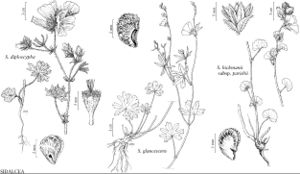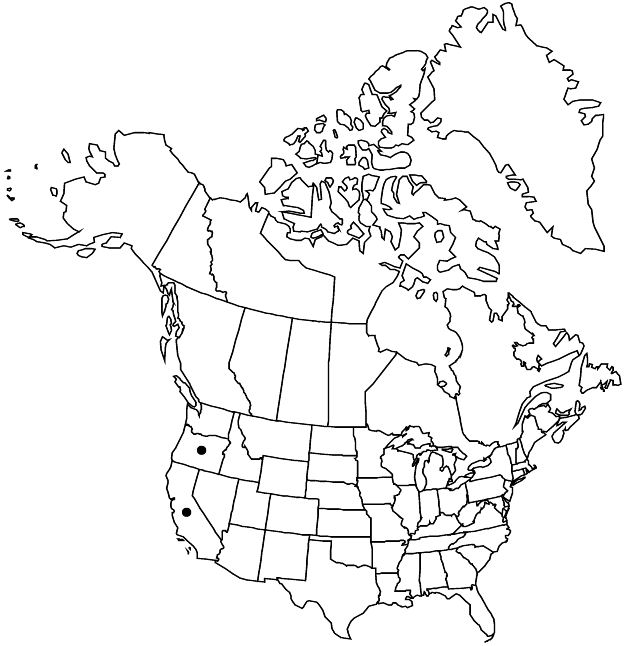Difference between revisions of "Sidalcea diploscypha"
Mem. Amer. Acad. Arts, n. s. 4: 19. 1849.
FNA>Volume Importer |
imported>Volume Importer |
||
| (5 intermediate revisions by 2 users not shown) | |||
| Line 13: | Line 13: | ||
}}{{Treatment/ID/Special_status | }}{{Treatment/ID/Special_status | ||
|code=F | |code=F | ||
| − | |label= | + | |label=Illustrated |
}} | }} | ||
| − | |basionyms={{Treatment/ID/ | + | |basionyms={{Treatment/ID/Basionym |
|name=Sida diploscypha | |name=Sida diploscypha | ||
|authority=Torrey & A. Gray | |authority=Torrey & A. Gray | ||
| + | |rank=species | ||
| + | |publication_title=Fl. N. Amer. | ||
| + | |publication_place=1: 234. 1838 | ||
}} | }} | ||
|synonyms={{Treatment/ID/Synonym | |synonyms={{Treatment/ID/Synonym | ||
|name=Sidalcea diploscypha var. minor | |name=Sidalcea diploscypha var. minor | ||
|authority=A. Gray | |authority=A. Gray | ||
| + | |rank=variety | ||
}} {{Treatment/ID/Synonym | }} {{Treatment/ID/Synonym | ||
|name=S. secundiflora | |name=S. secundiflora | ||
| − | |authority= | + | |authority= |
| + | |rank=species | ||
}} | }} | ||
|hierarchy=Malvaceae;Malvaceae subfam. Malvoideae;Sidalcea;Sidalcea diploscypha | |hierarchy=Malvaceae;Malvaceae subfam. Malvoideae;Sidalcea;Sidalcea diploscypha | ||
| Line 49: | Line 54: | ||
-->{{#Taxon: | -->{{#Taxon: | ||
name=Sidalcea diploscypha | name=Sidalcea diploscypha | ||
| − | |||
|authority=(Torrey & A. Gray) A. Gray | |authority=(Torrey & A. Gray) A. Gray | ||
|rank=species | |rank=species | ||
| Line 63: | Line 67: | ||
|publication title=Mem. Amer. Acad. Arts, n. s. | |publication title=Mem. Amer. Acad. Arts, n. s. | ||
|publication year=1849 | |publication year=1849 | ||
| − | |special status=Endemic; | + | |special status=Endemic;Illustrated |
| − | |source xml=https:// | + | |source xml=https://bitbucket.org/aafc-mbb/fna-data-curation/src/2e0870ddd59836b60bcf96646a41e87ea5a5943a/coarse_grained_fna_xml/V6/V6_599.xml |
|subfamily=Malvaceae subfam. Malvoideae | |subfamily=Malvaceae subfam. Malvoideae | ||
|genus=Sidalcea | |genus=Sidalcea | ||
Latest revision as of 22:22, 5 November 2020
Herbs, annual, 0.2–0.7 m, not glaucous, with taproot. Stems single, erect, usually branched distally, solid, both short-stellate-puberulent and long soft bristly-hairy, hairs erect. Leaves basal, early-deciduous, and cauline; mid to distal stem stipules divided into 2–5 filiform or linear segments, involucrelike, 10+ × 1 mm; petiole (4–)6–20(–50) cm, usually 1/2 times to as long as blade; basal leaf blades orbiculate, unlobed, 1–2.5 × 1–2.5 cm, base cordate, margins crenate, apex rounded; cauline leaf blades orbiculate, palmately 5–7-lobed, (1–)2–6 × (1–)2–6 cm, lobes linear distally, sometimes 3-toothed or -lobed, then midtooth or lobe much longer than laterals, margins entire, surfaces bristly-puberulent. Inflorescences erect, dense, calyces overlapping, occasionally short-branched, clusters to 10-flowered, subumbellate to elongate in age, not 1-sided; bracts linear or filiform, palmately 2–7-lobed, 8–12 mm, lobes linear, usually becoming involucrelike, 1–2.5 cm, subequal to or longer than calyx. Pedicels 1–3 mm, (short branches may easily be mistaken for pedicels); involucellar bractlets absent. Flowers bisexual; calyx 8–12 mm, not much accrescent, lobes often with narrow purple line or spot at lobe base inside, outer surface bristly-hairy and stellate-puberulent, seldom densely glandular, multicellular hairs usually few or absent; petals dark pink to deep purple, veins often paler, darker patch sometimes at base, 20–35 mm; staminal column 4–6 mm, hairy; anthers sessile on rim, white; stigmas 5 or 6. Schizocarps 6–7 mm diam.; mericarps 5 or 6, sometimes pinkish when fresh, 2.5 mm, glabrous, back minutely hairy, back and sides reticulate-veined, back with prominent midvein, not pitted, mucro absent. Seeds 2 mm. 2n = 20.
Phenology: Flowering Apr–May(–Jun).
Habitat: Grasslands, open woodlands, valleys, near vernal pools, usually on serpentine
Elevation: 0–900 m
Discussion
Sidalcea diploscypha is widespread in central and northern California and occurs also in Douglas County, Oregon, where it is apparently introduced. Young plants, even in flower, may resemble S. keckii, and transitional plants are known; S. diploscypha generally differs from S. keckii by its longer divided bracts, usually entire lobes on its distal stem leaves, simple bristles on the calyx, bristles absent at the standard mucro position on the mericarp, relatively few glandular and multicellular hairs, and generally clustered flowers and fruits. Plants in Colusa, Napa, Solano, and Yolo counties, California, are sometimes hard to distinguish from S. keckii, and vice versa. Some plants in Butte and Lake counties, California, also show some transitional features; none have yet been assigned to S. keckii.
Selected References
None.

